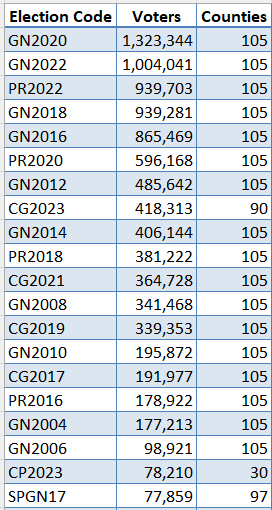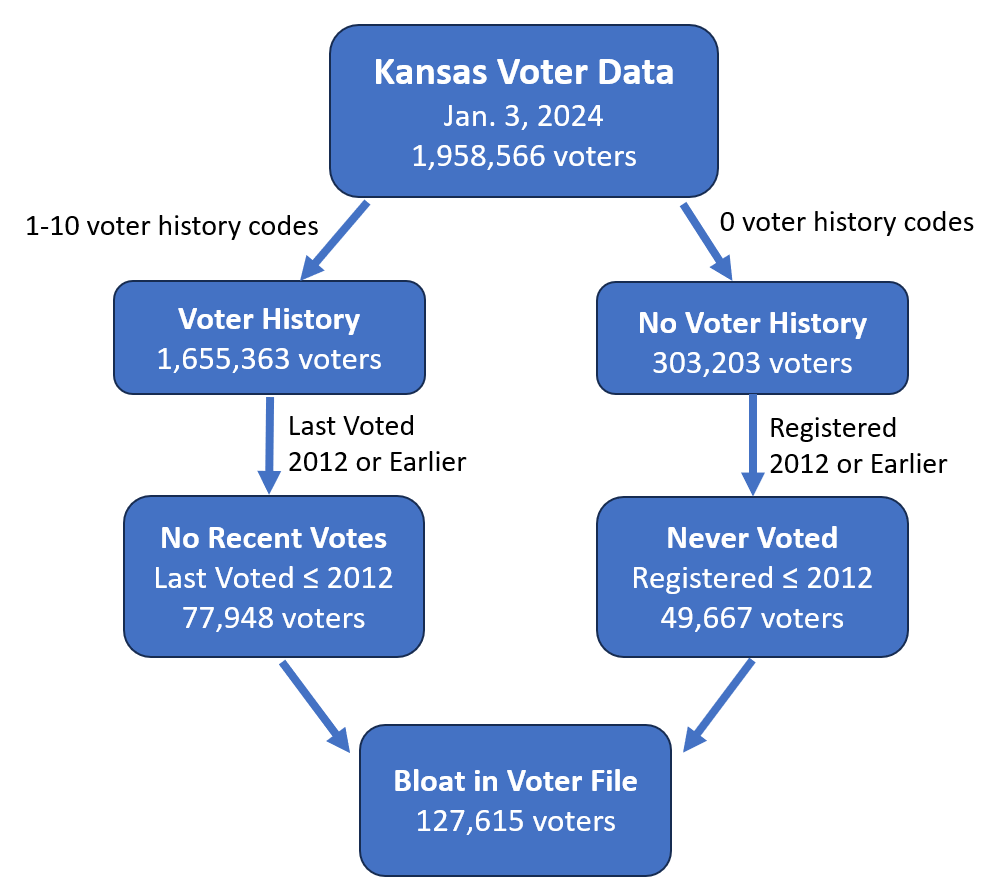Nearly 128,000 Kansas registered voters have not voted in 12 years
"Voter history" in voter files reveals when a voter last cast a ballot
Updated with information about KSA 25-2316c(e)(5).
Nearly 50,000 potential Kansas voters, who registered in 2012 or before, have never voted.
Another 78,000 Kansas registered voters voted in one or more elections, but have no voter history documenting those ballots were cast after 2012.
Why are these voters still on the rolls?
The 2022 legislature modified a law to help flag such voters, but it’s slow to remedy the problem.
KSA 25-2316c(e)(5) says:
(e) A county election officer shall send a confirmation notice upon which a registrant may state such registrant's current address, within 45 days of the following events: …
5) if the registrant has no election-related activity for any four-calendar year period. No election-related activity means that the elector has not voted, attempted to vote, requested or submitted an advance ballot application, filed an updated voter registration card, signed a petition, which is required by law to be verified by the county election officer or the secretary of state, or responded to any official election mailing transmitted by the county election office.
January 2024 voter data
The data for 1,958,566 Kansas registered voters from Jan 3, 2024 were analyzed. Each voter record has 10 fields for “voter history” — a code that indicates which elections a voter has participated in.
In round numbers, the nearly 2 million voters in the Jan. 3rd file have about 11 million history codes. So, an “average” voter has 5 or 6 voter history codes in their record.
There is no known list of Kansas voter history codes, but such a list can be reverse-engineered by studying voter data files.
The codes mostly follow a pattern: XXyyyy. Each code usually has a two-character prefix (XX), followed by a four-digit year (yyyy).
The prefixes include
“GN” (Nov. general election in even years),
“PR” (Aug. primary election in even years),
“CG” (Nov. general election for local elections in odd years — formerly “city general”)
“CP” (Aug. primary election for local elections in odd years)
“SP” (Special election)
“MB” (Mail ballot only election)
“PP” (Presidential Primary")
The table below shows the “top 20” of 1239 voter history codes along with the number of voters and the number of counties reporting those codes. The numbers for a particular election drop over time as voters are removed from the voter rolls.

The count of 90 counties for CG2023 — the Nov 2023 general election — is a bit curious. Did all 105 counties have elections in Nov 2023?
Careful comparison of the Jan. 2024 file with the Aug. 2023 file showed four other variations of the “CG2023” code were used by some counties: CG0023, CG1123, CG23, and CG294B. It’s unclear why there are such variations and how often similar variations have occurred with other history codes. Are such inconsistencies ever corrected?
Another problem shown in the above table is code SPGN17 (likely “special general election 2017”), which only uses a 2-digit year instead of a 4-digit year. It breaks the pattern.
Hundreds of other codes not shown also do not follow such a regular pattern — many are very old — but their counts are fairly small.
Data Flow Diagram
The data flow diagram below shows the breakdown of the 2 million Kansas voters by the number of voter history codes and the year of an election.
Overall, nearly 128,000 voters have not cast a ballot since 2012.

Voter Data Quality
Like many government databases that are “managed” without an active feedback loop, voter registration files in all states have a number of data quality problems.
The vast majority of Kansas voter history codes follow a pattern and contain the election year as the last four characters of the code.
But, mail ballot (MB) codes in particular are a mess with combinations of MByymm and MBmmyy as well as MByyyy. A very careful study of many voter files over time might reveal the “exact” meaning of the inconsistent mail ballot codes.
Only MByyyy codes were considered in this analysis. It’s possible some of the 77,948 voters identified as having no recent votes might have cast a mail ballot with a code that cannot be deciphered. A similar problem occurs with the SP (special election) codes.
A recent WatchdogLab article opined that Kansas needs a new approach to fixing problem data in voter files. Birthdate problems were discussed in that article, but voter registration date problems are also a problem.
Included in the 49,667 voters without history are some voters with problem registration dates and years, namely nine voters with registration years of 202, 230,1800, 1801, 1900, 1901 and one voter from the future with registration year 2200!
For now, it’s unknown how many of the 77,948 voters with history should have not been included because of undecipherable voter history codes.
Data quality is important to the public and often assumed. Some action should be taken by the county clerks and election offices to measure data quality problems.
Those metrics should guide actions to improve data quality over time. If I were Secretary of State, I would monitor all counties and give them feedback publicly. Healthy metric comparisons among counties would be the “peer pressure” for improvements.
Mostly ignoring data quality problems is not satisfactory, but that has been the modus operandi for years — for many government offices.
Missing “trigger” events to mark a voter “inactive”?
One likely reason many of these 128,000 voters have not been removed after 12 years, is the “trigger” event that marks a voter as “inactive” is not reliably happening.
Voter are marked “inactive” and the process of removal starts when an election office receives returned mail from the post office for a voter, or when National Change of Address from the Post Office indicates a voter has moved.
These processes are not working or many of these 128,000 voters would have been purged several years ago.
Do election offices study examples of processes failing to discover how they might be improved?
How can data problems ever be improved in Kansas voter files? Public monitoring and reporting data quality metrics would be a start.
Data
The “No History Inspect” and the “With History Inspect” Excel files are available upon request for election integrity researchers to study what’s happening in a local county or city.
To receive the files one must certify compliance with KSA 25-2320a, which prohibits using information derived from voter registration records for commercial purposes.






